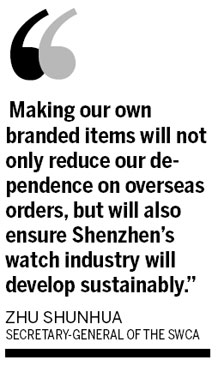Time is right for watchmakers
Updated: 2012-01-14 10:04
By Liu Lu (China Daily)
|
|||||||||||
Shenzhen's manufacturers look to dominate global trade in timepieces
BEIJING - No matter in which part of the globe you stand, the chances are that you won't be far away from a watch shop, and that many of the watches, expensive or not, will have come from one place: Shenzhen. Over the past 20 years the former fishing village in southern Guangdong province has become the world's largest outsourcing base for timepieces.
Watchmaking in Shenzhen began to blossom when the industry in neighboring Hong Kong started to migrate northward into the mainland in the 1980s. About 1,100 watch companies now call Shenzhen home, and they produced 800 million watches in 2010, accounting for more than 43 percent of global production, according to the Shenzhen Watch and Clock Association (SWCA). More than 80 percent were exported, particularly to Europe and the US.
But watchmakers in Shenzhen are no longer content to remain a manufacturing center for overseas brands. They are trying to reshape the old business models by investing heavily in branding their own independently designed products, aspiring to upgrade Shenzhen from the hub for the world's watch original equipment manufacturers (OEMs) to a place that produces its own top brands.
"Making our own branded items will not only help to reduce our dependence on overseas orders but, more importantly, will ensure Shenzhen's watch industry will develop sustainably," said Zhu Shunhua, secretary-general of the SWCA.
Zhu said the global financial crisis has led to a sharp drop in orders from Europe and the US, where most of the outsourcers are situated, forcing a rethink about Shenzhen's watch industry.
"Enhancing innovation, research and development capabilities as well as strengthening brand-building efforts, are vital for Shenzhen watchmakers to survive the increasingly intense competition both at home and abroad," Zhu said.

He added that by the end of last year more than 150 watch companies in Shenzhen had set up their own brands, 37 percent of them having developed about 600 intellectual property rights and patents.
As the world's largest watch-outsourcing base, Zhu said the quality of Shenzhen-made watches is guaranteed, but the city's watchmakers will have their work cut out to step into the high-end market because of a lack of brand-awareness.
"The high prices of Swiss-made watches are a result not only of their quality, but also of brand-awareness," Zhu said.
"Shenzhen watch manufacturers should learn from their Swiss competitors to persuade more people to see 'Made in Shenzhen' as a quality seal."
In the race to upgrade, some watchmakers in Shenzhen have already made big strides.
The Hong Kong-listed Ebohr Luxuries International Ltd is one of a number of pioneering enterprises that have dedicated themselves to creating Chinese watch brands that will be recognized by all.
Ebohr, established in Shenzhen about 20 years ago, started as a processing and assembly factory making watches on order for companies in Europe and the US, but the slim profit margins prompted Tao Li, the founder and managing director, to build his own watch empire.
"We could only earn HK$8 ($1) for each watch we made at that time," Tao said. He realized that the labor-intensive outsourcing business relied heavily on overseas orders, resulting in restricted room for development in the long run.
Ebohr's rising popularity has driven up its brand value, which was put at about 1.8 billion yuan ($285 million) by the consultancy World Brand Lab in 2010.
But Tao wants more: he would like Ebohr to rank among the world's top watch brands.
As part of the strategy to realize that ambition, Ebohr has become the first watch business in Shenzhen to start using advanced 3D design software from Dassault Systemes SA of France to optimize its design process.
It also works with Swarovski Crystal of Austria, using its gemstones in its latest watch for women.
Since 2009, the company has hired master designers from Switzerland, who not only design watches, but also provide extensive training for Ebohr's Chinese staff.
"Even Ebohr's counter and merchandise displays in department stores are designed by our European professionals," said Tao.
As more international brands covet the vast Chinese market, the watchmakers in Shenzhen are also facing increasing pressure to win over more consumers in the domestic market, especially in the mid- to high-end segment.
"We have to cultivate our own consumer groups by enhancing our brand recognition," said Sha Hengyi, president of Shenzhen Geya Watches Co Ltd.
Sha said Swiss timepieces have an edge in their brand heritage, but Shenzhen watchmakers enjoy the advantage of having an abundant supply chain and wide distribution channels, but most importantly, they understand Chinese consumers better.








